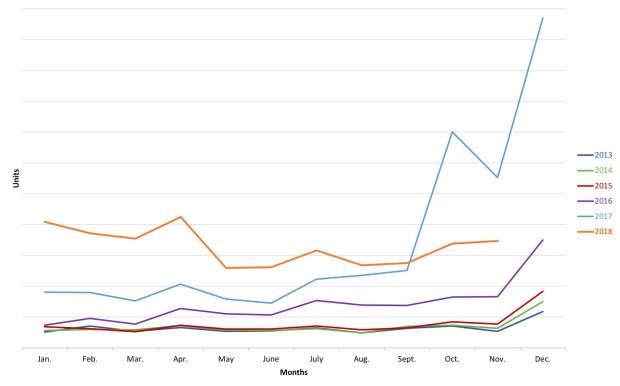Viral verse: Poets of Instagram inject new life, fresh voices into poetry genre
An international fanbase. Throngs anticipating each live appearance or social media update. Their work tattooed onto devotees' bodies. Celebrity collaborations. The late-night talk show circuit. Merchandising.
It's not Hollywood's latest It-girl or music's flavour of the month but the reality for today's biggest Instagram poets.
After decades on a downward trajectory, poetry has been enjoying a renaissance thanks to a generation of young, accessible writers breathing new life into the literary form. They're speaking directly to a massive pool of readers via Instagram, and though not without criticism, Instapoets have inspired passionate fans who say they haven't ever seen themselves reflected in this way.
Noted writer and spoken word artist Harman Kaur, 19, studied English literature at Simon Fraser University and says so many perspectives were missing from the material.
"All I was dealing with was literature and all I didn't see in that literature was myself," she said.

Kaur, a Punjabi Sikh from Abbotsford, B.C., discovered the poetry of Rupi Kaur (no relation) on Tumblr and then had a eureka moment when she saw the fellow Canadian's book for sale in a bookstore.
"Up until that point, I had never seen the last name Kaur on the spine of a book," she recalled.
The Milk and Honey author — coming from a similar background — made her feel she too could become a writer. This spring, Kaur self-published Pulkari, her debut book of poetry and prose.
The rise of Rupi Kaur
Poetry is a long-suffering genre, its death regularly pondered and its popularity declining for years, the Washington Post reported in 2015.
Enter 26-year-old Indo-Canadian poet Rupi Kaur. In 2015, her self-published debut Milk and Honey was picked up by Andrews McMeel Publishing, a company that first dabbled in the genre with Australian Instagram poet Lang Leav's 2013 collection Love and Misadventure.
By early 2016, Kaur's book of bite-sized confessional poems about female empowerment, desire, love and abuse — poems often accompanied by her minimalist sketches — was a New York Times bestseller. Devotees were captivated by her work, describing it as raw, straightforward, accessible and resonating with their lives.
Kaur's sophomore collection The Sun and Her Flowers, released in October 2017, is listed on BookNet's list of the 10 bestselling non-fiction books for the second year in a row.
Though poetry sales in Canada enjoyed small increases since 2013, print unit sales in poetry jumped 85.2 per cent between 2015 and 2016, according to BookNet, which analyzes and reports on the Canadian book industry.
The following year, that figure rose to 138.4 per cent — a leap BookNet attributes almost entirely to Rupi Kaur's sales.

In April, BookNet noted that Kaur's two collections had ousted Leonard Cohen's The Book of Longing from its perch atop the company's list of the highest-selling print poetry books (based on sales data it began collecting in 2005).
Fellow Instapoets like Atticus and r.h. Sin have also helped pushed the likes of Homer and John Milton off BookNet's tally.
"I never expected [my poetry] to resonate with anybody and was very surprised when it did," Canadian poet Atticus, a celebrity favourite who hides his identity behind a silver Guy Fawkes mask, said from Victoria this week.

"The nicest compliment I can get is when somebody messages me and says, 'You know, you said what I was thinking, but I didn't know how to articulate it'.... I really try to write honestly about these human things that I go through and the ups and downs of life," said the author of the bestselling collections Love Her Wild and The Dark Between Stars.
However, the mainstream success of Instapoets hasn't come without a wide-ranging backlash, which has ranged from satirical jabs at the simple style favoured by many Instapoets to allegations of plagiarism to straight up condemnation from traditional poets dismissing it as the work of amateurs.
Fans, however, view Instapoets as trailblazers stretching boundaries — in form, subject matter and distribution — backed by a literary establishment that, they point out, doesn't have a great track record for championing the work of women, people of colour or young people.
"Every kind of literary genre has evolved over the years, and to say that [Rupi Kaur] has to abide by some classical standard — you know, it doesn't make sense," said young poet Shany Raitsin, a student at Toronto's Ryerson University.
"She pairs her work with drawings. It confuses some people. 'Why is this woman talking about her period? Why is she talking about her heartbreak and why is she so successful for it?'.... It just works. It just clicked with people."
Poetry as therapy
Instapoets openly share thoughts on everything from unabashed romance to suffering sexual violence to bodily functions — and that's inspired Raitsin and her peers to take up the mantle.
In turn, they're using poetry to express themselves, to process challenges they're grappling with and to heal from trauma.

"I always used to write for myself. I never used to share it," said student and poet Mattie Hodge.
"I think we're so caught up in the fact that we can't share our emotions. We have to bottle it. Everything has to be OK … I started realizing that everybody else can relate and share those experiences."
For fellow student Sidra Jafri, writing poetry has become a valued coping mechanism.
"I put my frustration and all my mental [distress] into my poetry.… If you can just pour your heart out onto a piece of paper, it helps a little bit," she said.
"We use … our art as therapy."
A gateway to more?
Ryerson poetry professor Dale Smith says he's happy to have students excited by, and eager to share, work found outside the classroom.
"I don't think of poetry as something that's confined to a particular media format," he said, noting that the poetry can take the form of dramatic performance or illustration, be created with or accompanied by sound or even be a combination of different forms.
"I think the great thing about the internet right now is that you can mix these different media styles together to produce something that's really evocative and interesting," Smith said.
Smith hopes Instagram poets will serve as a gateway to a greater variety of poetry and other writing, and inspire engagement in a wider culture of discourse — especially with voices that challenge and don't directly mirror readers' own perspectives.
"If Rupi Kaur and Instapoetry became only about reproducing forms of success without a critique somewhere in it; if it shut out [for instance] voices of queer, anti-capitalist, challenging poets … if that somehow made [these voices] go away, I think that would be a problem."
B.C.'s Harman Kaur believes that today's Instapoets are simply employing the medium that most effectively disseminates their work to the widest possible audience — something writers have always attempted to do.
"If William Shakespeare was alive today, he would be on Instagram," Kaur declared.


